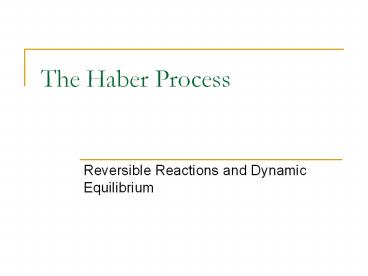The Haber Process - PowerPoint PPT Presentation
Title:
The Haber Process
Description:
Improving the yield of ammonia in the Haber process In the Haber process the pressure is set as high as possible to give the best % yield. – PowerPoint PPT presentation
Number of Views:4345
Avg rating:3.0/5.0
Title: The Haber Process
1
The Haber Process
- Reversible Reactions and Dynamic Equilibrium
2
Reversible Reactions
- Remember this?
- The Haber process is a REVERSIBLE reaction
- N2(g) 3H2(g) 2NH3(g) (
heat) - nitrogen hydrogen ammonia
- A reversible reaction is one where the products
of the reaction can themselves react to produce
the original reactants.
3
Reversible Reactions
- If you dont let any reactants or products
escape, both forward and backward reactions can
happen at the same time. Reactants make products,
and, at the same time, products make reactants. - When the forward and backward reactions go on at
the same rate a state of dynamic equilibrium
exists.
4
Reversible Reactions
- In the Haber process we want the dynamic
equilibrium to mover to the right so that lots
of ammonia is made (and not much N and H is left
around)
5
Reversible Reactions
- The french chemist Le Chatelier worked all this
lot out!!! - In a dynamic equilibrium the position of the
equilibrium will shift in order to reverse any
changes you introduce.
6
Reversible Reactions
- Factors that can affect a reversible reaction
include - Changing temperature
- Changing concentration
- Changing pressure
7
Improving the yield of ammonia in the Haber
process
- Effect of pressure
- On the left hand side there are 4 moles of gas,
whilst on the right hand side there are 2 moles - Any increase in pressure will favour the forward
reaction to produce more ammonia. - This is because the forward reaction will tend to
decrease the pressure in the system.
8
Improving the yield of ammonia in the Haber
process
- In the Haber process the pressure is set as high
as possible to give the best yield. - High pressure containers are VERY expensive.
- It could be possible to carry out the reaction at
1000 atmospheres but this would not be
economical (it would cost more than the product
is worth). - The typical pressure used is 200 to 350
atmospheres.
9
Improving the yield of ammonia in the Haber
process
- The reaction produces heat when it moves to the
right. - This means that a LOWER temperature would favour
the forward reaction, BUT. - Reactions go slower at lower temperatures!
- In operating the Haber process you have to decide
what is more important, the higher YIELD you can
get at lower temperatures or the higher RATE at
higher temperatures.
10
Improving the yield of ammonia in the Haber
process
- In order to get ammonia produced at a quicker
RATE the reaction is carried out at a high
temperature (450oC). - It is better to get just a 10 yield in 20
seconds (at a high temperature) that a 20 in 60
seconds (at a lower temperature)
11
- It took over 6500 experiments at different
temperatures and pressures carried out by the
German Carl Bosch to work all this lot out. - He got a Nobel Prize for it in 1931!
- (Haber got his Nobel Prize in 1918)
12
Other ways of increasing the yield in the Haber
process
- An IRON catalyst makes the reaction occur more
quickly, (it does not affect the yield i.e. the
position of the dynamic equilibrium). - Without the catalyst the temperature would have
to be much higher (this would lower the yield).
13
Other ways of increasing the yield in the Haber
process
- Removing the ammonia from the system also pushes
the reaction to the right so more ammonia is
produced to replace it.
14
(No Transcript)































